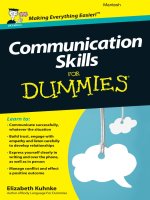Communication skills for tourism
Bạn đang xem bản rút gọn của tài liệu. Xem và tải ngay bản đầy đủ của tài liệu tại đây (1013.16 KB, 65 trang )
Communication Skills for
Tourism
Semester II
Dr. Sangeetha C.P
Subject Code: 18MTT24C
Assistant Professor
UNIT - II
ORAL COMMUNICATION
INTRODUCTION TO ORAL COMMUNICATION:
❖
The word communication is derived from a Latin word meaning “to share”.
❖
Communication can be defined as “purposefully and actively exchanging
information between two or more people to convey or receive the intended
meanings through a shared of signs and (symbols)”
❖
Oral communication is communication by speaking rather than in some other
way.
❖
Learn more about the types and benefits of oral communication, and find out
how you can improve your own oral communication abilities.
ADVANTAGES
There is high level of understanding and transparency in oral communication
as it is interpersonal.
There is no element of rigidity in oral communication.
There is flexibility for allowing changes in the decisions previously taken.
The feedback is spontaneous in case of oral communication. Thus, decisions
can be made quickly without any delay.
Oral communication is not only time saving, but it also saves upon money and
efforts.
Oral communication is best in case of problem resolution.
Oral communication is an essential for teamwork and group energy.
DISADVANTAGES:
Relying only on oral communication may not be sufficient as business
communication is formal and very organized.
Oral communication is less authentic than written communication as they are
informal and not as organized as written communication.
Oral communication is time-saving as far as daily interactions are concerned,
but in case of meetings, long speeches consume lot of time and are
unproductive at times.
Oral communications are not easy to maintain and thus they are unsteady.
There may be misunderstandings as the information is not complete and may
lack essentials.
It requires attentiveness and great receptivity on part of the receivers/audience.
ESSENTIAL S OF EFFECTIVE COMMUNICATION
Clear pronunciation
Brevity
Precision
Conviction
Logical sequence
Appropriate word choice
Avoid hackneyed phrases & clichés
Natural voice
Finding the right register
TYPES OF ORAL COMMUNICATION
Face to face
Video conferencing
Telephone
Active-passive communication
Interviews
Group discussion
Presentations
Grapevine
PARALINGUISTIC FEATURES
INTRODUCTION
Component of non verbal communication.
Includes intentional and unintentional non verbal messages.
It may be – complementary, unconscious and learned.
They are the aspects of spoken communication that do not
involve words.
Study of the non verbal cues and signals of the voice.
COMPONENTS OF NON-VERBAL COMMUNICATION
Kinesics
Paralinguist
ic
Proxemics
Non-verbal
communicatio
n
Chronemic
s
Oculesics
Haptics
CUES OF PARALINGUISTICS:
Volume of voice
Speed of voice
Intonation
Tone
Pronunciation
Articulation
Pause
Punctuation marks
FEATURES OF PARALINGUISTICS:
Body language
Gestures
Facial expressions
Tone and
Pitch of voice
Are all examples of paralinguistic features. Paralinguistic features of language
are extremely important as they can change message completely.
DEFINITION
Proxemics is the study of space and how we use it, how it makes us feel more
or less comfortable, and how we arrange objects and ourselves in relation to
space.
Core Concepts and Assumptions
1. There are four types of distances people keep: intimate (0 to 18 inches), personal (18
inches to 4 feet), social (4 to 10 feet), and public (over 10 feet).
2. The distances outlined are those deliberately chosen by individuals. Forced closeness
doesn’t factor in proxemics.
3. Proxemics behaviour is learned mostly from observing others rather than from
explicit instruction, which is why personal distance and physical contact varies by
culture.
4. The physical distance between communicators indicates the type of relationship they
have. Body angles, touch and eye contact further reveal the familiarity between people.
5. Americans generally prefer 18 inches of personal space.
Types of Territories
There are four main kinds of territories in proxemics:
1. Body Territory – refers to the personal space, or “bubble,” that one
maintains around their person.
2. Primary Territory – one’s home, vehicle or other living space.
3. Secondary Territory – a structured place where entry is reserved for
particular individuals and certain norms are expected, such as a school, office
or church.
4. Public Territory – an open space where anyone can come and go, such as a
park or shopping mall.
HAPTICS
DEFINITION
Haptic communication is a branch of nonverbal communication that refers to the ways
in which people and animals communicate and interact via the sense of touch. Touch is
the most sophisticated and intimate of the five senses.
Application
➢ Touch communication is an effective and intimate way to handle and nurture the children.
Anything communicated through touch would be more effective compared with other
forms of communication as touch involves physical attachment.
➢ Haptic communication is applied with physically challenged students, where they learn
through touch.
ReplyForward
➢ Haptic communication widely used in the field of AI (Artificial Intelligence and Robotics
sensor system), This system supports the medical haptic methods in surgical and other
applications. In the Entertainment industry, the emergence of haptic methods and the
haptic sensor provides adequate support for computing and gaming.
Importance of Haptics
1.Touch gives us a sense of presence
2. Sensory experience helps us explore the world
3. Haptic feedback makes action possible
4. Touch is essential to emotional connection and wellbeing
5. Your sense of touch is astonishingly acute
6.Hand brushing wheat in a field is the next big thing
Group Discussion
What is Group Discussion?
"Group" is a collection of individuals who have regular contact and frequent interaction and
who work together to achieve a common set of goals.
"Discussion" is the process whereby two or more people exchange information or ideas in a
face-to-face situation to achieve a goal. The goal, or end product, maybe increased
knowledge, agreement leading to action, disagreement leading to competition or resolution
or perhaps only a clearing of the air or a continuation of the status-quo.
★
★
★
★
★
group of candidates
having a common desire
given a topic or situation
given few minutes to think
then asked to discuss
What are the types of Group Discussion?
Types of
GD
Case Based
Topic Based
Factual Topic
Controversial Topic
Abstract Topic
Types of Group Discussions
Factual topics are about practical things, which an ordinary person is aware of in his
day-to-day life. Typically these are about socio-economic topics. These can be
current, i.e. they may have been in the news lately, or could be unbound by time. A
factual topic for discussion gives a candidate a chance to prove that he is aware of
and sensitive to his environment.
E.g. The education policy of India, Tourism in India, State of the aged in the nation.
Abstract topics are about intangible things. These topics are not given often for
discussion, but their possibility cannot be ruled out. These topics test your lateral
thinking and creativity.
E.g. A is an alphabet, Twinkle twinkle little star, The number 10
Controversial topics are the ones that are argumentative in nature. They are meant to
generate controversy. In GDs where these topics are given for discussion, the noise level
is usually high, there may be tempers flying. The idea behind giving a topic like this is
to see how much maturity the candidate is displaying by keeping his temper in check, by
rationally and logically arguing his point of view without getting personal and
emotional.
E.g. Reservations should be removed, Women make better managers
Another variation is the use of a case instead of a topic.
The case study tries to simulate a real-life situation. Information about the situation will
be given to you and you would be asked as a group to resolve the situation. In the case
study there are no incorrect answers or perfect solutions. The objective in the case study
is to get you to think about the situation from various angles.
IIM A, IIM Indore and IIT SOM Mumbai have a case-based discussion rather than topicbased discussion in their selection procedures.
Why Group Discussion?
❖ It helps you to understand a subject more deeply.
❖ It improves your ability to think critically.
❖ It helps in solving a particular problem.
❖ It helps the group to make a particular decision.
❖ It gives you the chance to hear other students' ideas.
❖ It improves your listening skills.
❖ It increases your confidence in speaking.
❖ It can change your attitudes.
Processes in Group Discussion
Prepare
Present
Group Discussion involves two Process









